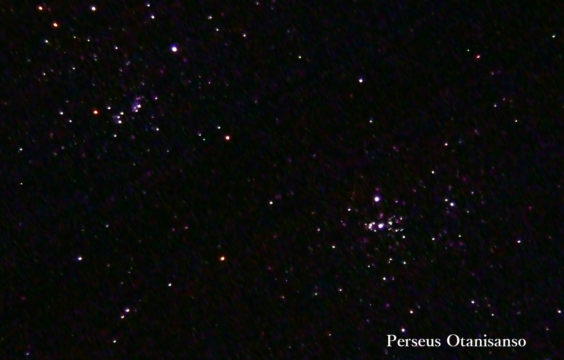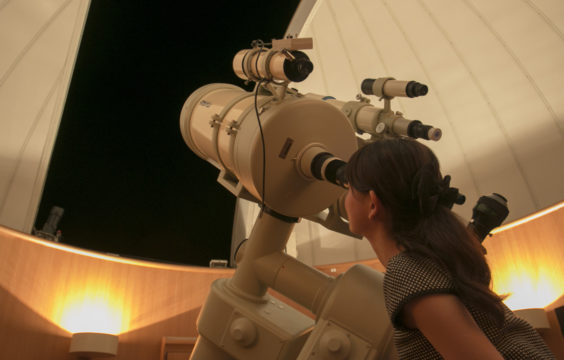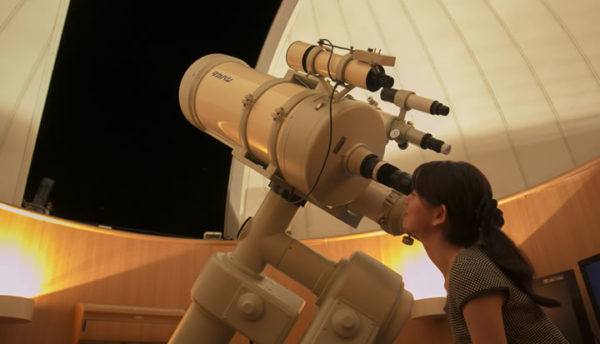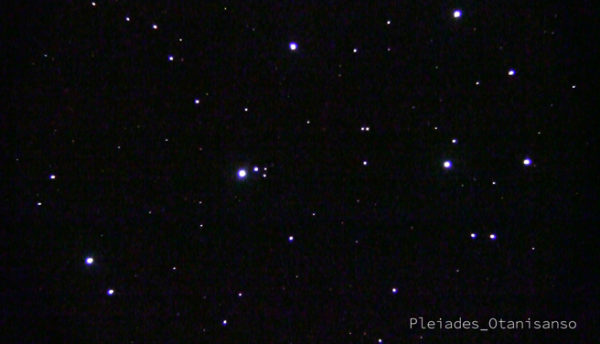- Astronomical Observatory
- 2019/11/27
【November in the Observatory】Why is winter star-gazing season? The winter constellations will appear, sparkling brightly in the eastern sky
The Pleiades star cluster, famous for the star Subaru, will come into view. Come out and see the Star Mira, in whale constellation Cetus at its best.
 Hello, this is the Otani Sanso Astronomical Observatory Dome.Today we’ll be discussing what’s visible in Nagato Yumoto Onsen’s night skies in November, 2019. (Image: A photograph of the Pleiades star cluster and Subaru, taken through the telescope at Otani Sanso’s astronomical observatory dome in the past)
Hello, this is the Otani Sanso Astronomical Observatory Dome.Today we’ll be discussing what’s visible in Nagato Yumoto Onsen’s night skies in November, 2019. (Image: A photograph of the Pleiades star cluster and Subaru, taken through the telescope at Otani Sanso’s astronomical observatory dome in the past)
During winter, many star clusters and first magnitude stars can be seen with the naked eye
Since November began, the stars in the eastern sky have begun to appear ever faster. The star-gazing season has arrived at last. More than any other time of year, the stars appear at their most beautiful in winter. The reason for this is that the cold air makes for clear viewing, and there may be fewer particulates in the air, but with many bright first magnitude stars, and clusters of stars like the Pleiades star cluster and Orion nebula, there is plenty to be enjoyed with the naked eye, too. Highlights of this month’s star-gazing include the Alpha Persei Cluster and the Pleiades in the constellation of Perseus, which came into view last month, and the star Mira in the constellation of Cetus, which will reach its peak viewing condition in mid-November. The star Mira is named with the Latin for “wonderful” or “astonishing.” It is a pulsating variable star, and its brightness changes as the size of the star itself changes. It is expected to reach its peak in mid-November, but as its name suggests, it is difficult to predict exactly with what brightness we’ll be able to see the star. During this period, take some time to search for Mira together with the observatory staff. The next object of focus is the Pleiades star cluster. This winter constellation is familiar to the Japanese as “Subaru.” Located relatively close to the earth (at a distance of about 408 light years), it’s known as an open star cluster with several tens of blue/white stars. The blue/white shimmer of these stars is proof of how incredibly hot they are burning. Because of their intense burn, it’s said that the stars live relatively short lives of around 1 hundred million years. 6 of these stars are visible with the naked eye. When you connect each of these stars…can you see a familiar logo? As you head home from your trip, we encourage you to take a look up at the night sky.What is an open cluster?
Stars are constantly being born from gas and dust. Typically, stars are born in cluster shapes. These young star clusters are known as open star clusters. (Image: A photograph of an open cluster. Perseus Double Cluster, photographed through the telescope at Otani Sanso’s astronomical observatory dome in the past)
See more details about the Perseus Double Cluster
Legends surrounding the stars of November: What is the pulsating variable star Mira, in the constellation Cetus?
The star Mira, in the constellation of Cetus, will reach its peak in mid-November. Located right in the chest area of this whale-shaped constellation, this star (a pulsating variable star) shines with dramatically different light depending on when it is viewed. Usually, astronomical brightness is measured in terms of magnitude: for example, Spica (in the constellation Virgo), a star that shines in the summer skies, is a first magnitude star. So what magnitude is Cetus’ Mira? The answer is that for a period of about 332 days, its brightness fluctuates from anywhere between second magnitude and 10th magnitude. Why does it have so much variation? As it turns out, Mira is nearing the end of its life, and the star is in an unstable state, in which is grows and shrinks in size. Because of this, the star grows in size and cools = gets dimmer (minimum – 10th magnitude), and shrinks in size and grows hotter = gets brighter (maximum – 2nd magnitude). The name given to stars whose actual volume grows and shrinks is a “pulsating variable star.” Because the timing of Mira’s fluctuations, and the brightness of its brightest period is not always the same, it’s a star whose pattterns are particularly difficult to predict. “Mira” is Latin for “wonderful” or “astonishing.” The star is expected to reach its peak in mid-November, but just how bright a star we may see will simply depend on the viewing time. In this chilly weather, when you bring your shoulders up to your ears for warmth, come search for something astonishing in the chill night sky above.*How to find Mira in the Cetus constellation-Reference: See “peak of Mira” image on the National Astronomical Observatory of Japan Website (Japanese only)
Information about the stars in September
Schedule of Expected Stellar Observations
- November 1st (Fri) – 2nd (Sat): Pleiades star cluster (Subaru), Perseus Double Cluster, Mira in the Cetus constellation
- November 3rd (Sun) – 15th (Sun): the Moon, Pleiades star cluster (Subaru), Mira in the Cetus constellation
- November 16th (Sat) – 30th (Sat): Pleiades star cluster (Subaru), Perseus Double Cluster, Mira in the Cetus constellation
Star-Gazing Topics in September
- Mid-November…Peak of Mira in the Cetus constellation
Please check the National Astronomical Observatory of Japan website for sunset times in Yamaguchi Prefecture. (See: National Astronomical Observatory of Japan Website)
Making a Reservation at the Astronomical Observatory

Details
- Observatory Hours… 7:30 p.m. – 10:10 p.m.
- Closed on… Every Tuesday
- Location… Otani Sanso Roof (Just beside the gallery on the 8th floor)
- Price… Free for overnight guests (Viewings available to those who reserve first)
- Using the Observatory… Viewings are available to those who reserve first (12 seats per viewing)
Observation Times
- 7:30 p.m., 7:50 p.m.
- 8:10 p.m., 8:30 p.m., 8:50 p.m.
- 9:10 p.m., 9:30 p.m., 9:50 p.m.
How to Make a Reservation
Please inform us of your desired reservation time from the times listed above (Please tell us via telephone, or write it in the “requests” field) *You may not be able to participate in a viewing if a time slot is fully booked, or due to weather conditions. *Should you be unable to participate in a viewing due to weather conditions, you will be able to see a video from a past viewing.See information from the astronomical observatory dome
■Frequently Asked Questions "Why is there an astronomical observatory on the roof of Otani Sanso?" The president of Otani Sanso, a great fan of the poems of Nagato/Senzaki-born Kaneko Misuzu, built the observatory out of a desire to "share the beautiful stars of Nagato with our guests, too." In fact, it was through a chance meeting via the Kaneko Misuzu Exchange Association that the president met with Dr. Haoru Saji, who greatly affected the president with the beauty of the stars he could see from the observatory at Tamagawa University even during the daytime. "There's much more than your eyes can see," Dr. Saji told him. "Let's take a look at the daytime stars." When you look up at the starry skies of Nagato, here, surrounded by nature, we hope you'll make memories to take home with you that you can look back on fondly.
Night Sky Trivia
The Speed of Light
- Light moves at a speed of approximately 300,000 km per second (7.5 revolutions around the Earth), and can cover 9.46 trillion km in a year.
- It takes light from the sun 8 minutes and 19 seconds to reach the earth.
- It takes 8 minutes and 19 seconds for light from the sun to reach the Earth.
Distances in Space
- Because space is so vast, we use “light years” and “astronomical units (AU)” to describe the distances between stars.
- 1 light year = the amount of distance light can travel in one year (9.5 trillion km)
- 1 astronomical unit = the distance between the sun and the Earth (approx. 150 million km)
Earth Time
- There are 24 hours in one day, but it takes 23 hours and 56 minutes for a rotation of the earth, leaving a margin of 4 minutes.
- The reason we have “leap years” is because the Earth’s orbital period around the sun is just shy of 365 Earth days.
- 1 rotation of the Earth (23 hours 56 minutes) = 400 m/sec
- 1 revolution of the Earth (365 days) = 30 km/sec
If you’d like to see more information about the night skies, the National Astronomical Observatory of Japan is extremely interesting. Please take a look.


